Adventure on the High Seas: The Annapolis-Newport Yacht Race
By Joseph Patrick Bulko
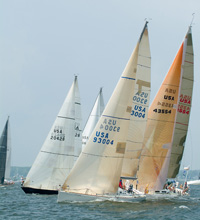
Ahoy mates! Prepare ye for the 2007 edition of the Annapolis to Newport Yacht Race, one of the most historic and well known of the U.S. East Coast blue water races. Starting June 1 and featuring about 70 sailboats spread over numerous racing classes, the much-anticipated event provides adventure on the high seas.
First run 60 years ago, the race links two seaports dating from our nation's birth, Annapolis and Newport, Rhode Island. The Annapolis Yacht Club organizes the race, with assistance from the Naval Academy Sailing Squadron, New York Yacht Club, and Newport’s Ida Lewis Yacht Club.
“The 475-mile race is a four-day event for most boats, depending on the boat type and the wind,” said Chip Taylor, AYC Race Committee Chairman. “The really big boats do it in 48 to 72 hours.” The record time is held by Carrera, Joseph Dockery's Farr 60 skippered by Chris Larson, which set a new course record in 2001 of 42 hours, 58 minutes, 12 seconds.
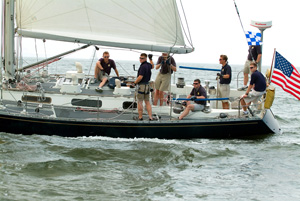
The race provides challenging diversity over different bodies of water, a contrast between the Chesapeake Bay and the Atlantic Ocean , as well as convenient ports of refuge along the entire course. The race is a favorite for first-time offshore competitors, as well as experienced blue water racers.
“The crews for the boats are all amateurs – ordinary folks who are into sailboat racing,” Taylor said. “They come from all walks of life and all age groups.” Among the perks of offshore racing is watching the sun rise and set on the open sea, and “the allure of being alone on the water.”
Each boat, which must be a minimum of 33 feet in length, features two full crews, with one sleeping while the other sails, he explained. Shifts can follow a four-hours-on and four-hours-off rotation, or on for six hours during the day and four hours at night. “There’s a real sense of camaraderie amongst the crew. We’re a close-knit group. You’re relying on your mates to take care of you.”

The course heads south for 120 miles from Annapolis to the Chesapeake Bay Bridge Tunnel, before turning east and hence northeast to Newport. After navigating the shallows and currents of the Bay, navigators must decide if they want to sail the rumbline (the most direct route) to Newport, go in towards the shore, or head farther into the ocean.
“Tactically, the race is a challenge,” Taylor noted. “You have choices to make all the way down the Bay and all the way up the coast. It’s the responsibility of the navigator and captain to make those decisions. Some boats go far offshore and some stay closer to land. You can go long stretches without seeing any other boats.”
The 2005 race was the first East Coast offshore race to offer full fleet tracking. This year, every boat will be equipped with a deck-mounted GPS transponder so that near real-time tracking will be available on the Internet throughout the race. “Every boat is tracked online in real-time all the time,” said AYC Racing Manager Linda Ambrose. “We know where every boat is at all times.”
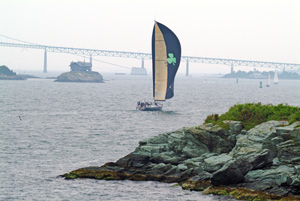
Online full fleet race tracking generates increased excitement for families, friends, and fans. Spectators follow the changing dynamics of the competition as the influences of weather, tactics, boats, and skill are felt during the course.
For an offshore boat race where many miles can separate vessels from each other, safety is always a concern, underscoring the value of the GPS technology. “Distance racing is getting more popular, and safety is key,” Ambrose added, while noting that racing offshore is a different kind of challenge than racing closed courses on the Bay.
“That’s what’s great about the Bay – there’s something for everyone,” Ambrose observed, referring to the different available boating adventures, which include power-boating, sail-boating, day sailing, and racing.
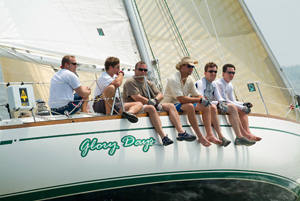
She said older people, who are tired of the work required to operate and maintain a sailboat, sometimes transition over to powerboats, which don’t need the same kind of constant attention or “tweaking” in order to get from point A to B.
Sponsored by Corum USA, as a test of its tracking system technology, the transponders track each boat’s location and progress. Accessible through any web browser, the Internet-based tracking program will be updated every two hours, providing position, speed, fleet, and class positions during the entire length of the course.
A popular feature of the 2005 race was the Yacht Club Challenge, where a club represented by at least three member boats competes as a team for the trophy. New in 2007 is the addition of a Double-Handed Division, which represents a rapidly growing segment of the offshore racing scene. Separate prizes are awarded to any racing class with six or more entries.
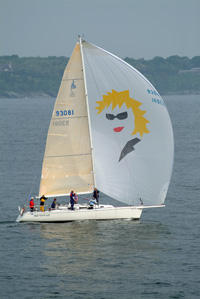
For the double-handed racers, where only two persons are onboard to sail the vessel, one crewmember sleeps while the other operates the boat, which is set up differently, Taylor explained. This is an event “for more experienced sailors.”
The Annapolis to Newport race is one of three offshore races included in the US-IRC Gulf Stream Series, which is made up of premiere events ranging from the Caribbean up the east coast to Nova Scotia. The other two races are the Pineapple Cup Montego Bay Race and the Marblehead to Halifax Race. At least one of these three races is required to qualify for the series.
Requirements for boat crews consist of “both captain and navigator having previous offshore experience, and 20 percent of the crew must take a safety at sea seminar,” Taylor explained. “There’s a long list of requirements for the boat itself, known as offshore regulations, and there’s lots of prep work for the boat.”
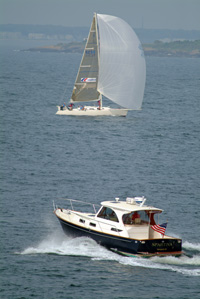
Does it ever get boring out there? Taylor was quick to point out that racing is not at all like day sailing. “We’re constantly making sure the boat is going its fastest. We’re constantly looking at the sails. We’re pretty busy the whole time on watch.”
The biennial Annapolis-Newport Race has existed in various forms back to 1871, 1875, and 1879 when the route consisted of a jaunt along the New Jersey coast from Sandy Hook to Cape May, with five or fewer entries competing in each race. After a big time gap, the yachts took sail again from 1927 to 1933 and in 1939 from New London, CT to Gibson Island here in Maryland.
In 1941, the race started in New London and ended in Hampton, VA, and during the same year, a Newport-Annapolis race was promoted, but World War II intervened. The race was officially established in 1947 to be on a continuing basis in alternate years with the Newport-Bermuda Race. Until the mid-1950s, it was the Newport to Annapolis race, but after much complaining by the competitors about slow trips up the Chesapeake after a long ocean race, the course was reversed in 1957.
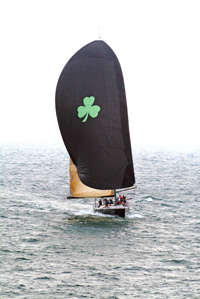
In 1965, the race hosted its largest fleet with 93 boats, and in 1955 its smallest with only 27 boats. The roughest racing year was 1967 when 34 of the 91 starters withdrew, several having been dismasted. E. Newbold Smith, who participated in 20 races starting in 1957, is the most frequent competitor. He was the overall winner in 1961, and finished first or second in his class on many subsequent occasions.
Sailboat racing is governed by the credo of finding “glory in winning,” not the achievement of cash prizes, Ambrose said, noting that the Annapolis to Newport event is “never a money-maker.”
The Players
Annapolis Yacht Club
2 Compromise St. Annapolis, MD 21401
Web: http://www.annapolisyc.org
Race Web: http://www.annapolisyc.org/newport07
410-263-9279
Chip Thayer, Race Committee Chairman
Annapolis Yacht Club
Email: cthayer@annapolisyc.org
302-478-0442
Linda B. Ambrose, Racing Manager
Annapolis Yacht Club
Email: lambrose@annapolisyc.org
410-263-9147 (office)
443-994-4235 (cell)
Back
|

